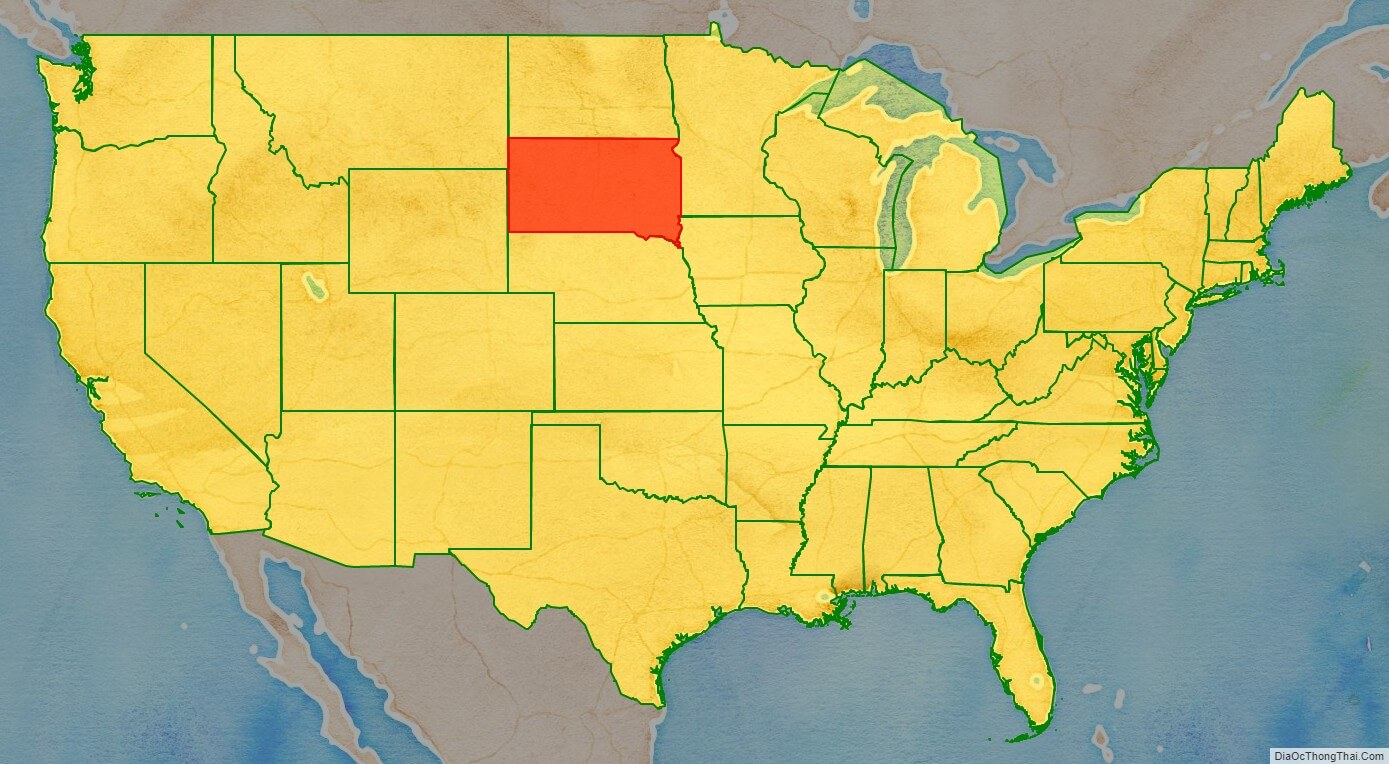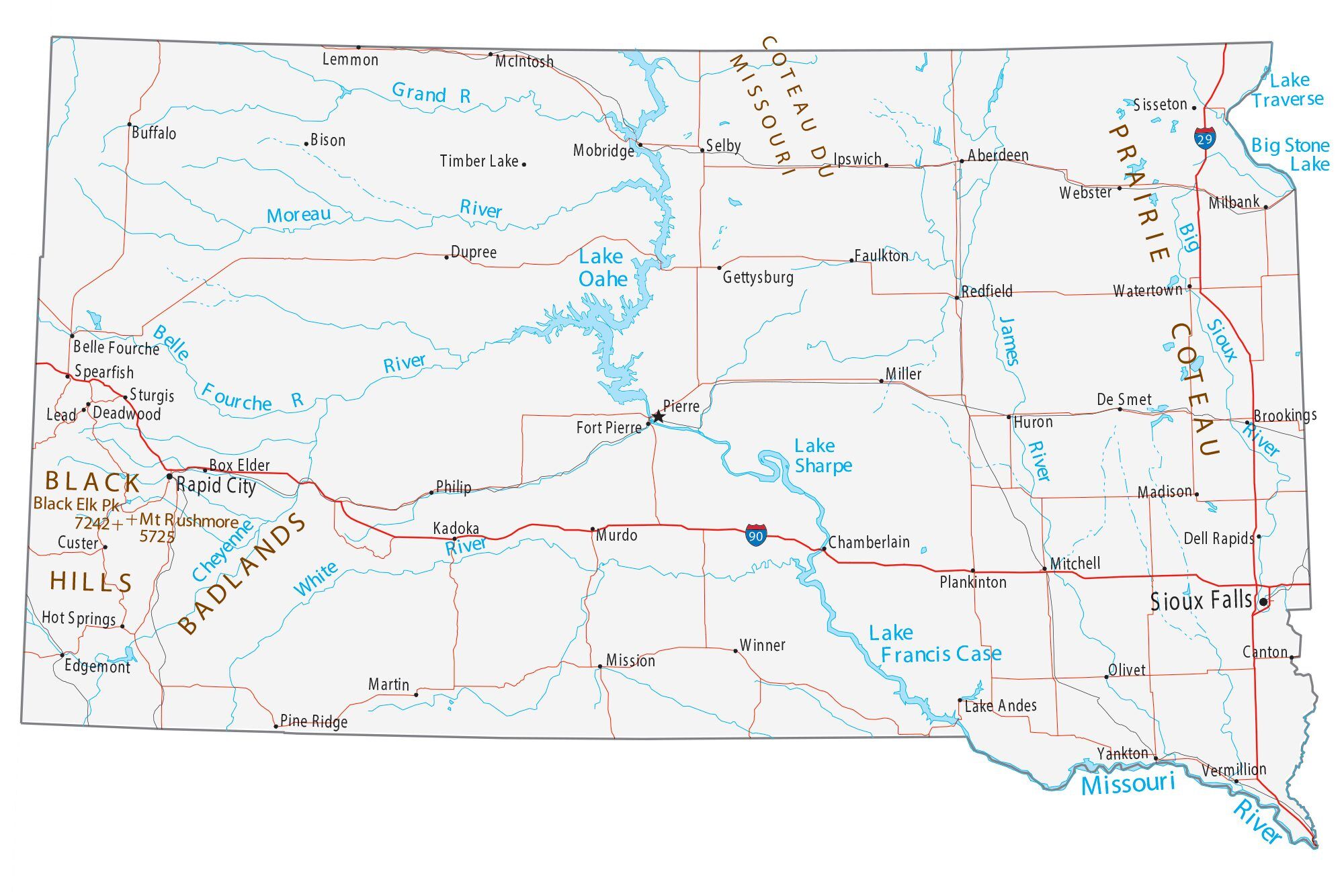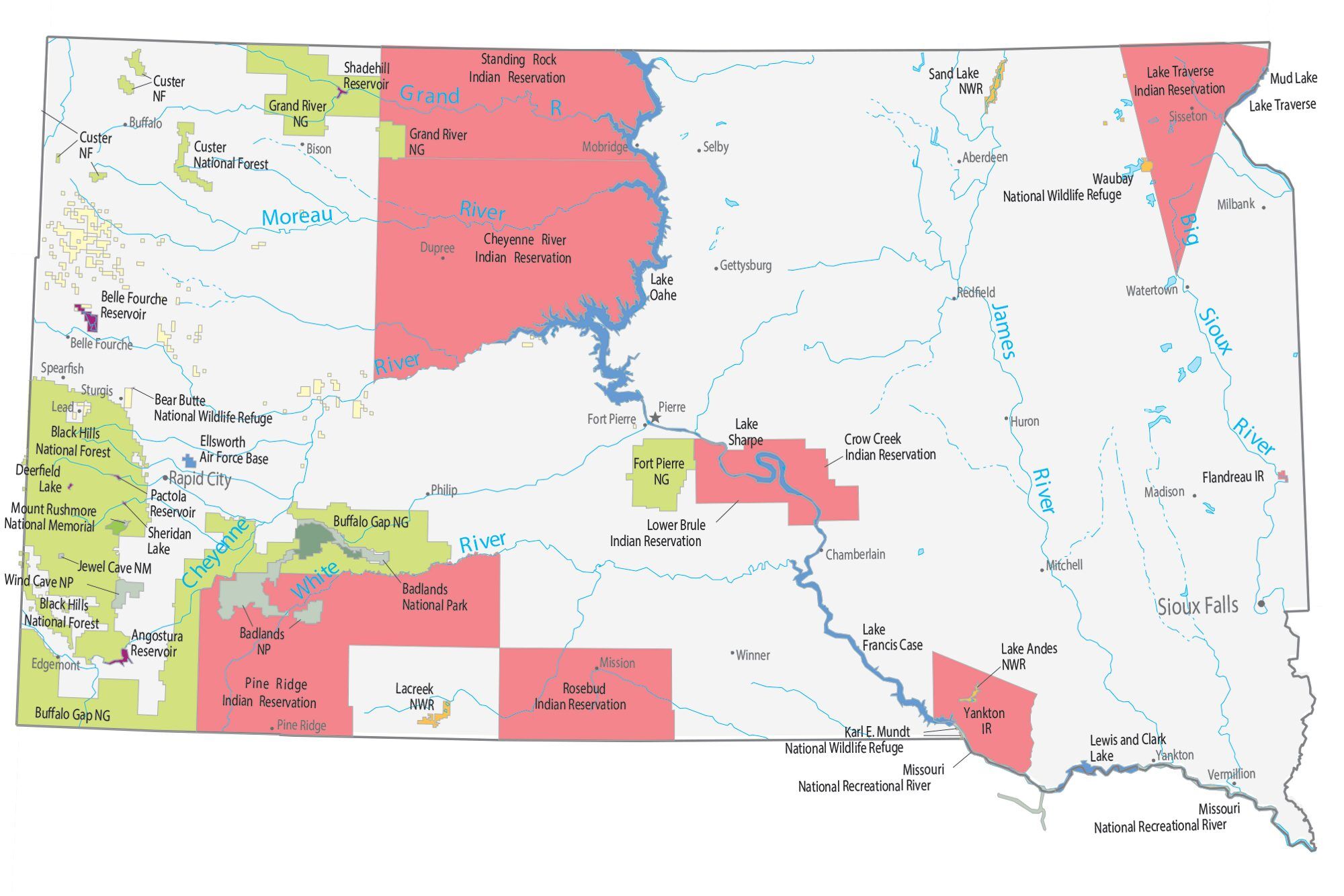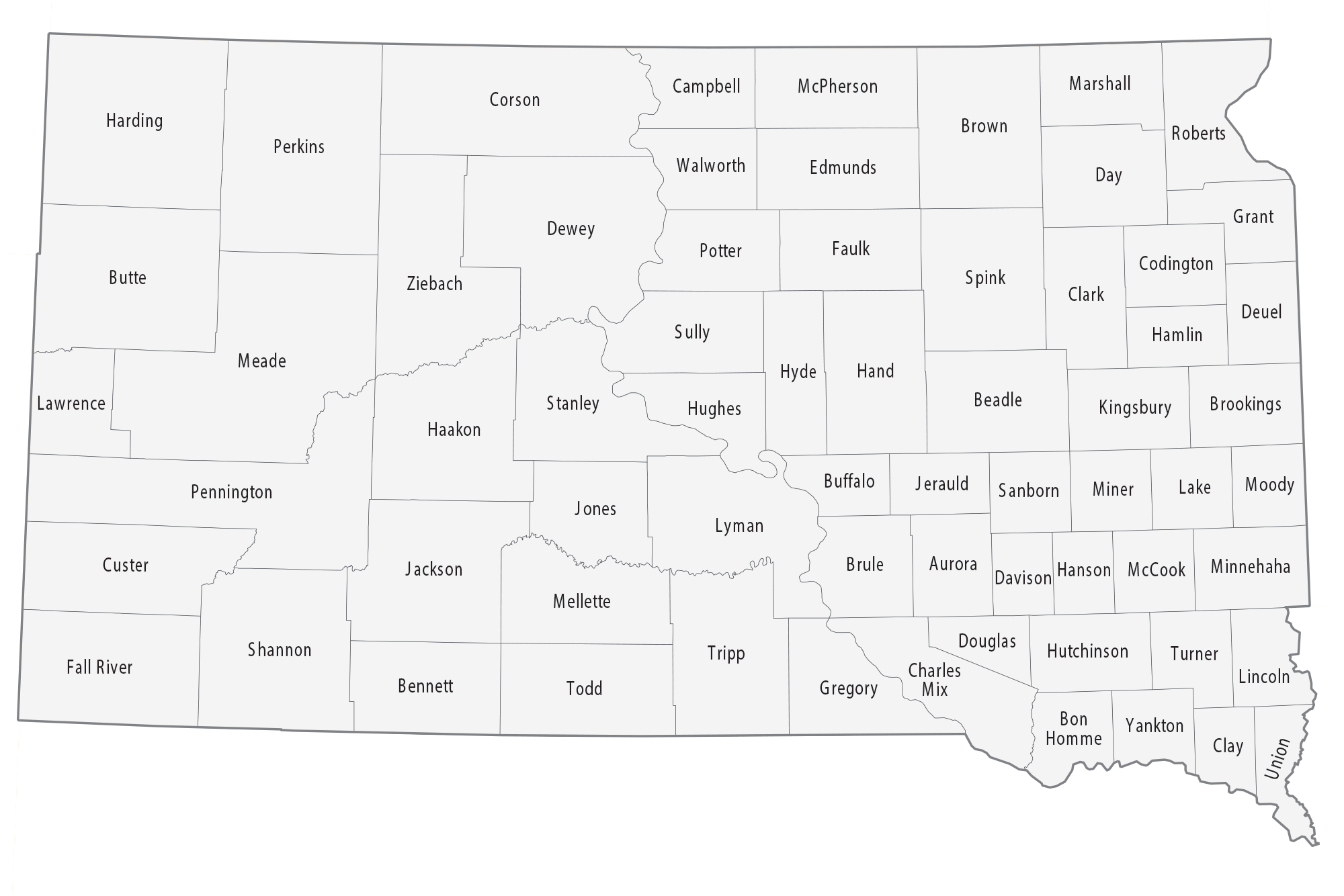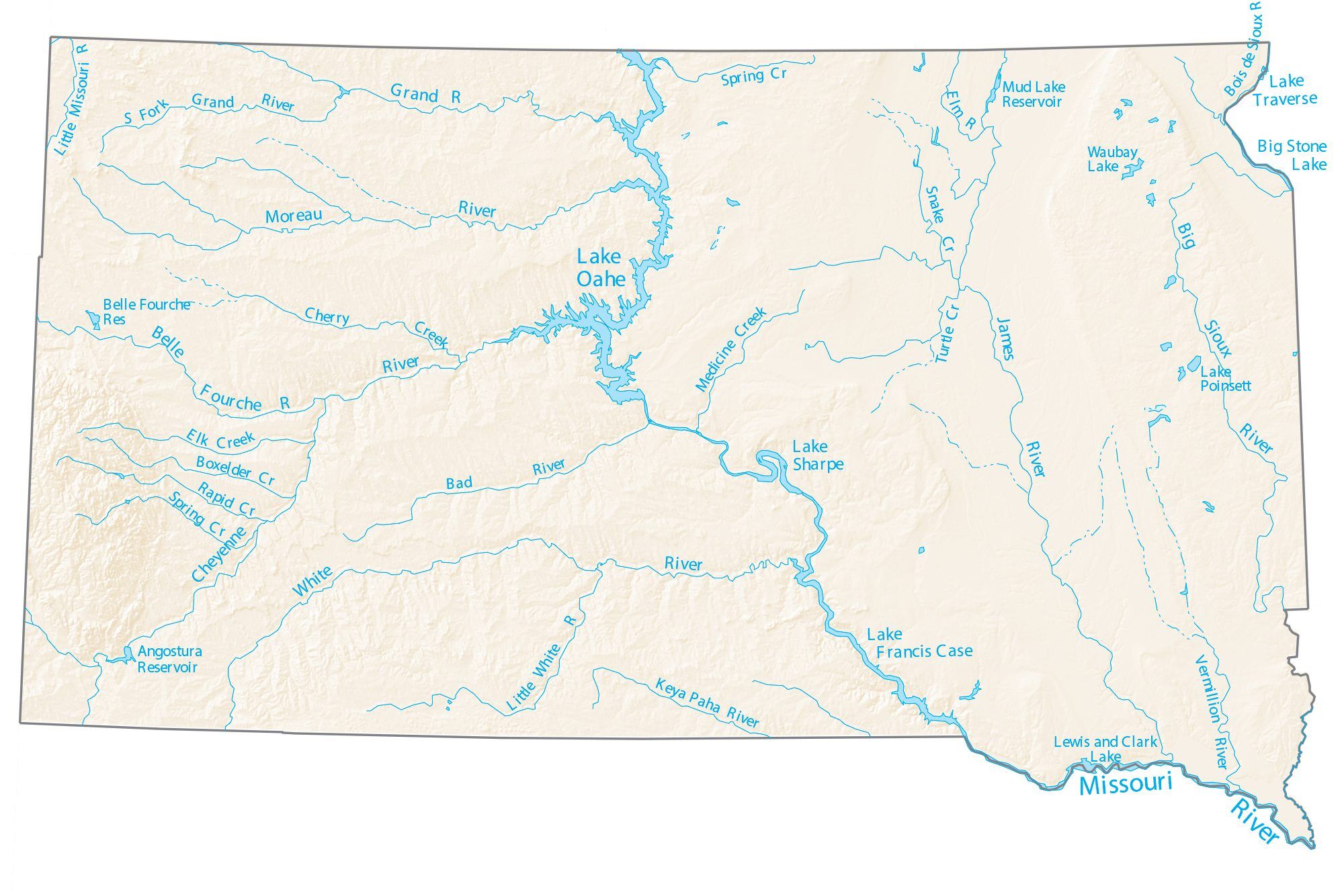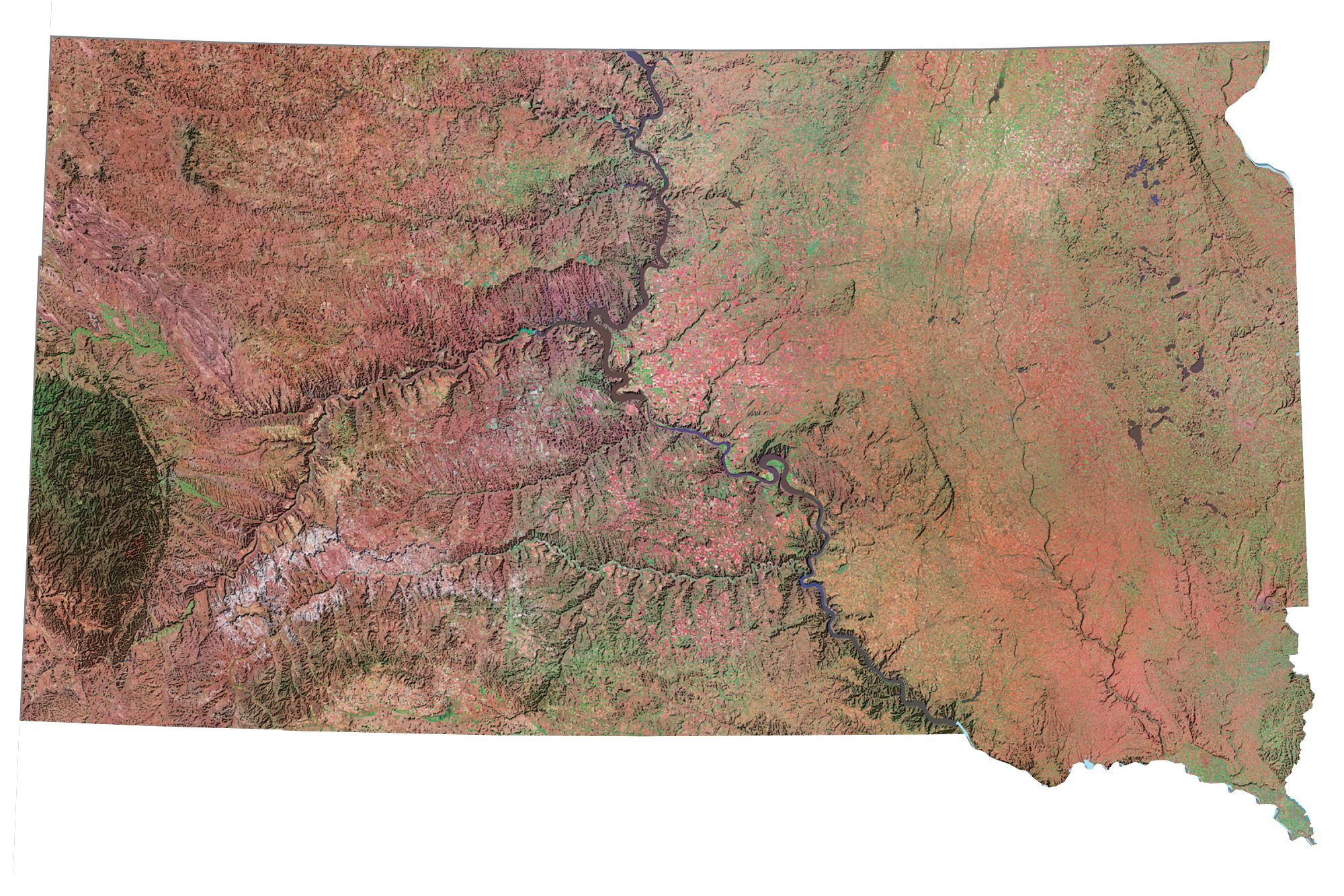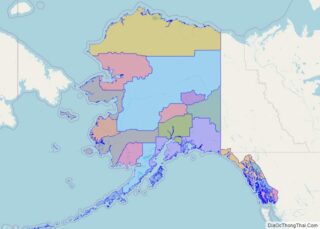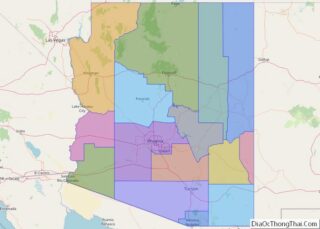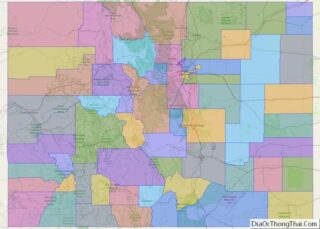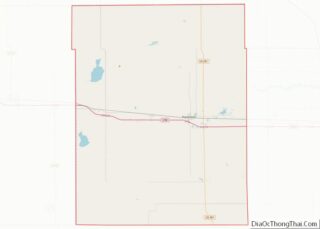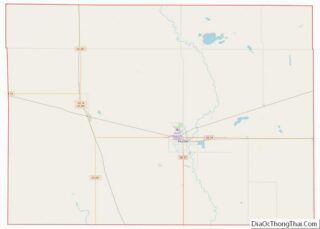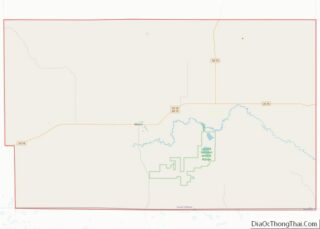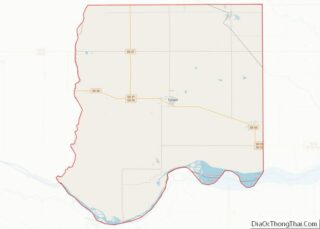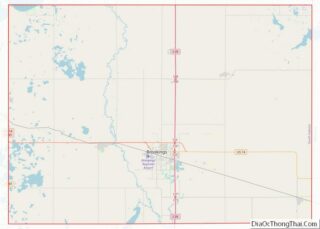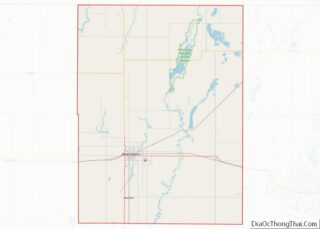South Dakota (/- dəˈkoʊtə/ (listen); Sioux: Dakȟóta itókaga, pronounced [daˈkˣota iˈtokaga]) is a U.S. state in the North Central region of the United States. It is also part of the Great Plains. South Dakota is named after the Lakota and Dakota Sioux Native American tribes, who comprise a large portion of the population with nine reservations currently in the state and have historically dominated the territory. South Dakota is the seventeenth largest by area, but the 5th least populous, and the 5th least densely populated of the 50 United States. As the southern part of the former Dakota Territory, South Dakota became a state on November 2, 1889, simultaneously with North Dakota. They are the 39th and 40th states admitted to the union; President Benjamin Harrison shuffled the statehood papers before signing them so that no one could tell which became a state first. Pierre is the state capital, and Sioux Falls, with a population of about 192,200, is South Dakota’s largest city.
South Dakota is bordered by the states of North Dakota (to the north), Minnesota (to the east), Iowa (to the southeast), Nebraska (to the south), Wyoming (to the west), and Montana (to the northwest). The state is bisected by the Missouri River, dividing South Dakota into two geographically and socially distinct halves, known to residents as “East River” and “West River”.
Eastern South Dakota is home to most of the state’s population, and the area’s fertile soil is used to grow a variety of crops. West of the Missouri River, ranching is the predominant agricultural activity, and the economy is more dependent on tourism and defense spending. Most of the Native American reservations are in West River. The Black Hills, a group of low pine-covered mountains sacred to the Sioux, is in the southwest part of the state. Mount Rushmore, a major tourist destination, is there. South Dakota has a temperate continental climate, with four distinct seasons and precipitation ranging from moderate in the east to semi-arid in the west. The state’s ecology features species typical of a North American grassland biome.
Humans have inhabited the area for several millennia, with the Sioux becoming dominant by the early 19th century. In the late 19th century, European-American settlement intensified after a gold rush in the Black Hills and the construction of railroads from the east. Encroaching miners and settlers triggered a number of Indian wars, ending with the Wounded Knee Massacre in 1890. Key events in the 20th century included the Dust Bowl and Great Depression, increased federal spending during the 1940s and 1950s for agriculture and defense, and an industrialization of agriculture that has reduced family farming.
While several Democrats have represented South Dakota for multiple terms in both chambers of Congress, the state government is largely controlled by the Republican Party, whose nominees have carried South Dakota in each of the last 13 presidential elections. Historically dominated by an agricultural economy and a rural lifestyle, South Dakota has recently sought to diversify its economy in other areas to both attract and retain residents. South Dakota’s history and rural character still strongly influence the state’s culture.
| Before statehood: | Dakota Territory |
|---|---|
| Admitted to the Union: | November 2, 1889 (40th) |
| Capital: | Pierre |
| Largest city: | Sioux Falls |
| Largest metro and urban areas: | Sioux Falls |
| Elevation: | 2,200 ft (670 m) |
| Total Area: | 77,116 sq mi (199,729 km) |
| Area Rank: | 17th |
| Total Population: | 909,824 |
| Population Rank: | 46th |
| Population Density: | 11.50/sq mi (4.44/km) |
| Population Density Rank: | 46th |
| Median Household Income: | $56,521 |
| Income Rank: | 33rd |
| Demonym(s): | South Dakotan |
| USPS abbreviation: | SD |
| ISO 3166 code: | US-SD |
| Website: | sd.gov |
Online Interactive Map
Click on ![]() to view map in "full screen" mode.
to view map in "full screen" mode.
South Dakota location map. Where is South Dakota state?
South Dakota Road Map
South Dakota Map – Roads & Cities
South Dakota Street Map
History
Humans have lived in what is today South Dakota for several thousand years. The first inhabitants were Paleoindian hunter-gatherers, and disappeared from the area around 5000 BC. Between 500 AD and 800 AD, a semi-nomadic people known as the Mound Builders lived in central and eastern South Dakota. In the 14th century, the Crow Creek Massacre occurred, in which several hundred men, women, and children were killed near the Missouri River.
By 1500, the Arikara (or Ree) had settled in much of the Missouri River valley. European contact with the area began in 1743, when the LaVérendrye brothers explored the region. The LaVérendrye group buried a plate near the site of modern-day Pierre, claiming the region for France as part of greater Louisiana. In 1762 the entire region became part of the Spanish Louisiana until 1802. By the early 19th century, the Sioux had largely replaced the Arikara as the dominant group in the area.
In 1803, the United States purchased the Louisiana Territory, an area that included most of South Dakota, from Napoleon Bonaparte, and President Thomas Jefferson organized the Lewis and Clark Expedition to explore the region. In 1817, an American fur trading post was set up at present-day Fort Pierre, beginning continuous American settlement of the area. In 1855, the U.S. Army bought Fort Pierre but abandoned it in 1857 in favor of Fort Randall to the south. Settlement by Americans and Europeans was by this time increasing rapidly, and in 1858 the Yankton Sioux signed the 1858 Treaty, ceding most of present-day eastern South Dakota to the United States.
Land speculators founded two of eastern South Dakota’s largest present-day cities: Sioux Falls in 1856 and Yankton in 1859. In 1861, the Dakota Territory was established by the United States government (this initially included North Dakota, South Dakota, and parts of Montana and Wyoming). Settlement of the area, mostly by people from the eastern United States as well as western and northern Europe, increased rapidly, especially after the completion of an eastern railway link to Yankton in 1873.
In 1874, gold was discovered in the Black Hills during a military expedition led by George A. Custer and miners and explorers began illegally entering land promised to the Lakota. Custer’s expedition took place despite the fact that the Sioux had been granted the entire western half of present-day South Dakota (West River) in 1868 by the Treaty of Laramie as part of the Great Sioux Reservation. The Sioux declined to grant mining rights or land in the Black Hills, and war broke out after the U.S. failed to stop white miners and settlers from entering the region. Eventually the U.S. won and broke up the Great Sioux Reservation into five reservations, settling the Lakota there. In 1980 the Supreme Court and Congress ordered compensation but the Lakota still refuse to accept it, insisting on return of their land.
A growing population in the Dakota Territory caused political dissatisfaction between northern and southern territory residents, with the southern half being always more populated. Following the territorial capital being moved from Yankton to Bismarck in the northern part, calls for dividing the territory increased. Eventually, in 1887 general election, Dakota Territory residents voted for the division, so it was divided in half and President Benjamin Harrison signed proclamations formally admitting South Dakota and North Dakota to the union on November 2, 1889. Harrison had the papers shuffled to obscure which one was signed first and the order went unrecorded.
On December 29, 1890, the Wounded Knee Massacre occurred on the Pine Ridge Indian Reservation. Commonly cited as the last major armed conflict between the United States and the Lakota Sioux Nation, the massacre resulted in the deaths of at least 146 Sioux, many of them women and children. 31 U.S. soldiers were also killed in the conflict.
During the 1930s, several economic and climatic conditions combined with disastrous results for South Dakota. A lack of rainfall, extremely high temperatures and inappropriate cultivation techniques produced what was known as the Dust Bowl in South Dakota and several other plains states. Fertile topsoil was blown away in massive dust storms, and several harvests were completely ruined. The experiences of the Dust Bowl, coupled with local bank foreclosures and the general economic effects of the Great Depression, resulted in many South Dakotans leaving the state. The population of South Dakota declined by more than 7% between 1930 and 1940.
Economic stability returned with the U.S. entry into World War II in 1941, when demand for the state’s agricultural and industrial products grew as the nation mobilized for war. In 1944, the Pick–Sloan Plan was passed as part of the Flood Control Act of 1944 by the U.S. Congress, resulting in the construction of six large dams on the Missouri River, four of which are at least partially in South Dakota. Flood control, hydroelectricity, and recreational opportunities such as boating and fishing are provided by the dams and their reservoirs.
In recent decades, South Dakota has been transformed from a state dominated by agriculture to one with a more diversified economy. The tourism industry has grown considerably since the mid-twentieth century, with the Black Hills becoming more important as a destination. The financial service industry began to grow in the state as well, with Citibank moving its credit card operations from New York to Sioux Falls in 1981, a move that has been followed by several other financial companies. South Dakota was the first state to eliminate caps on interest rates.
In 2007, the site of the recently closed Homestake gold mine near Lead was chosen as the location of a new underground research facility, the Deep Underground Science and Engineering Laboratory. Despite a growing state population and recent economic development, many rural areas have been struggling over the past 50 years with locally declining populations and the emigration of educated young adults to larger South Dakota cities, such as Rapid City or Sioux Falls, or to other states. Mechanization and consolidation of agriculture has contributed greatly to the declining number of smaller family farms and the resulting economic and demographic challenges facing rural towns. However, the state often ranks highly for its way of life, and Gallup’s well-being index in 2018 named South Dakota the happiest, healthiest state in the United States.
South Dakota State Map – Places and Landmarks
South Dakota Political Map
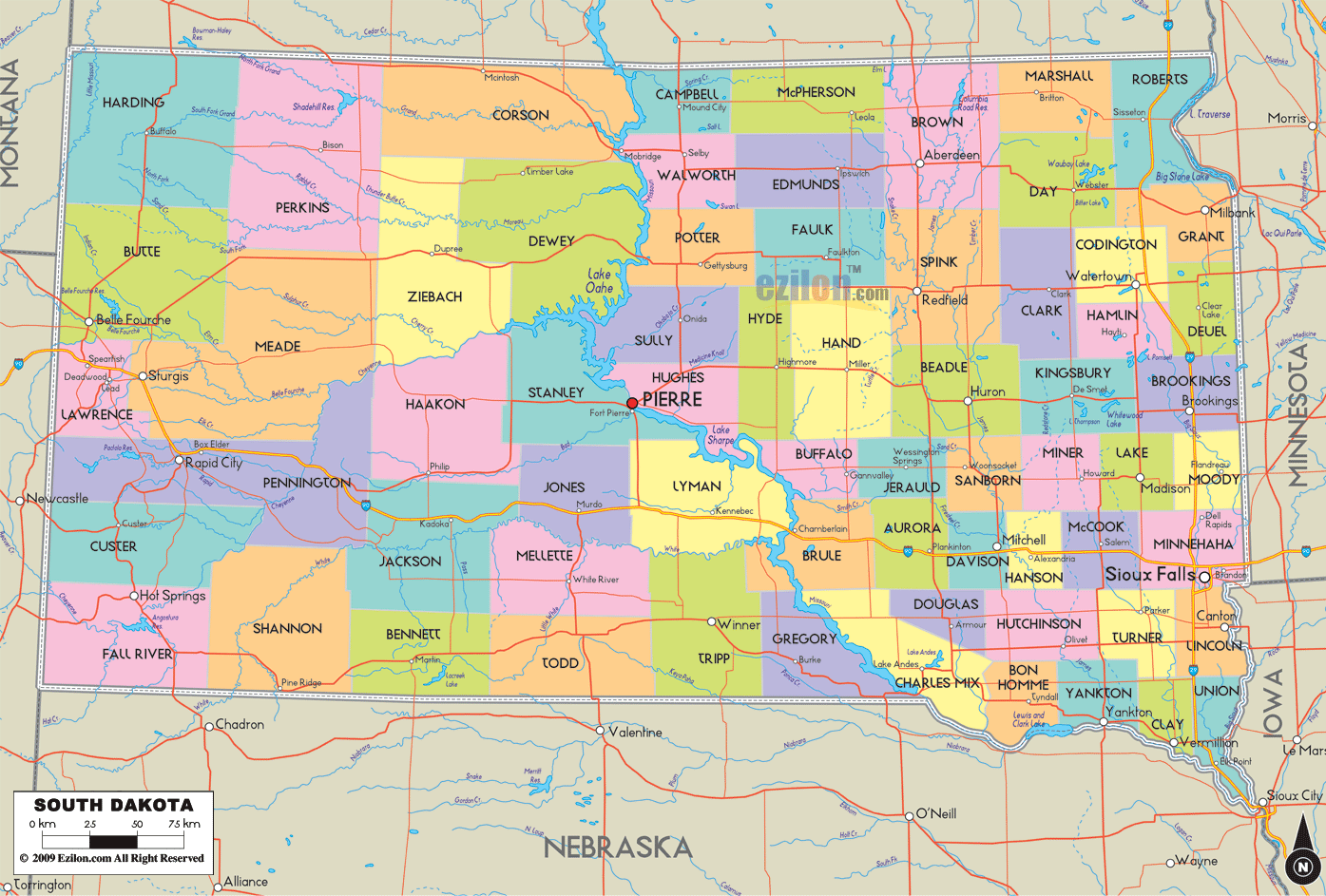
South Dakota Lakes and Rivers Map
South Dakota Physical Map
South Dakota Topographic Map
South Dakota Satellite Map
Others printable maps
South Dakota Outline Map
Blank South Dakota County Map
See also
Map of South Dakota State and its subdivision:- Aurora
- Beadle
- Bennett
- Bon Homme
- Brookings
- Brown
- Brule
- Buffalo
- Butte
- Campbell
- Charles Mix
- Clark
- Clay
- Codington
- Corson
- Custer
- Davison
- Day
- Deuel
- Dewey
- Douglas
- Edmunds
- Fall River
- Faulk
- Grant
- Gregory
- Haakon
- Hamlin
- Hand
- Hanson
- Harding
- Hughes
- Hutchinson
- Hyde
- Jackson
- Jerauld
- Jones
- Kingsbury
- Lake
- Lawrence
- Lincoln
- Lyman
- Marshall
- McCook
- McPherson
- Meade
- Mellette
- Miner
- Minnehaha
- Moody
- Pennington
- Perkins
- Potter
- Roberts
- Sanborn
- Shannon
- Spink
- Stanley
- Sully
- Todd
- Tripp
- Turner
- Union
- Walworth
- Yankton
- Ziebach
- Alabama
- Alaska
- Arizona
- Arkansas
- California
- Colorado
- Connecticut
- Delaware
- District of Columbia
- Florida
- Georgia
- Hawaii
- Idaho
- Illinois
- Indiana
- Iowa
- Kansas
- Kentucky
- Louisiana
- Maine
- Maryland
- Massachusetts
- Michigan
- Minnesota
- Mississippi
- Missouri
- Montana
- Nebraska
- Nevada
- New Hampshire
- New Jersey
- New Mexico
- New York
- North Carolina
- North Dakota
- Ohio
- Oklahoma
- Oregon
- Pennsylvania
- Rhode Island
- South Carolina
- South Dakota
- Tennessee
- Texas
- Utah
- Vermont
- Virginia
- Washington
- West Virginia
- Wisconsin
- Wyoming
